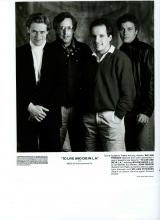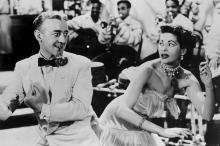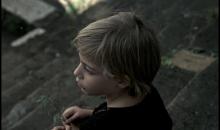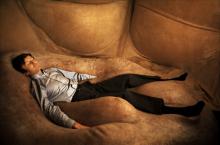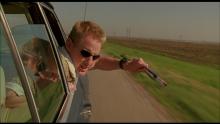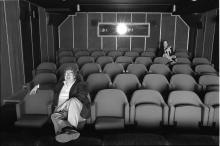This essay on William Friedkin's To Live and Die in L.A. was written by the UW Cinematheque's Ben Reiser. To Live and Die in L.A. will screen on Friday, September 26, 2015 at 7 p.m. in the Cinematheque's regular venue, 4070 Vilas Hall.
To Relive and Die in L.A.
By Ben Reiser
UW Cinematheque offers us the chance to revisit films we may have seen at other times in our lives, affording us the opportunity to see how our memory of these films compares to the reality of how they play out onscreen for us in our present day. In some cases, we may have previously seen a film only on TV, or at a drive-in while on a hot date, or on opening night with no idea what to expect. When I was eight years old, my grandparents took me to see The Towering Inferno, and my grandmother spent half of the first twenty-five minutes putting her hand over my eyes to shield me from any possible trauma, then a guy emerged, on fire, from an elevator, and we left. Four years ago my nine-year old daughter and I started watching that same movie on TV and she turned to me after a half hour to say, “This is boring” and left the room.
In any case, we bring something different to the table every time we watch a movie. No two viewings are ever quite the same, and revisiting a film tells us more about both the film and ourselves. Where we are in our lives affects what we are able to appreciate and understand when it comes to this art form.
What I brought to my first viewing of To Live and Die in L.A. was mostly Wang Chung. Sure, I knew who William Friedkin was, I’d seen (most of) The French Connection and (some of) The Exorcist on television, but if anyone had bothered to ask me why I was in Brooklyn New York’s Kingsway theater on the film’s opening weekend in 1985, I would have said (in the words of Mickey Rourke’s character, “Boogie”, at the beginning of Diner), “I’m only here because I appreciate the fine music.”
I’d first encountered Wang (then Huang) Chung a few years earlier while combing the racks of Titus Oaks, a used record store on Avenue U. I was intrigued by the album cover, which looked like an ornate Chinese restaurant menu.
I gambled $3.99 brought it home and immediately fell in love with a song called “Hold Back The Tears.” Two albums later I was still a fan, and when I found out the band had scored To Live and Die in L.A., I went out and bought the soundtrack album, and made plans to check out the movie.
My memories of that first viewing center on my enjoyment of the prominent role the score played in the film, the unsettlingly intense vibe of many of the performances, and the sense that the narrative was careening out of control at several key points in the movie. Every time I thought I had a handle on where the story was going, the plot took a jarring and nerve-wracking turn.
Looking back I realize it was my first encounter with many actors who are now household names. For instance, it was the first time I took notice of John Turturro, who would soon cement his status as an actor of uncommon force in The Color of Money. William Petersen, who stars as Secret Service agent, Richard Chance, would go on to complete an impressive leading man one-two punch the next year with his turn as Will Graham in Michael Mann’s Manhunter before fading into obscurity for over a decade (consider that not one but both of TV’s biggest CSI franchises were built around Friedkin stars who hadn’t been visible in the years leading up to their CSI star turns: Petersen and David Caruso, the star of Friedkin’s Jade,). Then, of course, there’s Willem Dafoe, whom I’d erased from my memory along with the rest of Walter Hill’s Streets of Fire only to have him freak me out all over again in To Live and Die…
Watching the film again this week it will be impossible for me to see it without the knowledge of these actors and all the roles they’ve inhabited in the ensuing years. This knowledge will in some way lessen the impact of their performances (now I know they are “only” actors) while at the same time perhaps deepen my appreciation of these actors who arrived on screen so rivetingly and fully formed.
What I bring to the table this week is the fact that I haven’t listened to a Wang Chung album in years, and I have a nagging fear that perhaps their score has not aged well, and might come off as more Hans Zimmer and less Tangerine Dream. I also bring with me a relatively newfound appreciation of Friedkin as a director, whose career resurgence has taken the form of lean, mean adaptations of Bug and Killer Joe and a recent restoration and Blu-ray release of his unjustly neglected Sorcerer.
And of course, those of us who saw Cinematheque’s screening of The French Connection a few weeks ago will be tempted to read To Live and Die in L.A. as a companion piece, a mirror, a re-telling of that earlier film, a comparative exploration of the similarities and differences between crime and punishment and law and order in the two cities that define our country’s coasts.
Certainly To Live and Die in L.A. invites these comparisons. For the first hour the film follows virtually the same structure as French Connection, and at the very least, I’d suggest that Friedkin does this deliberately if for no other reason than to further disorient us when things stop following the trajectory of his earlier masterpiece. Suddenly our roadmap disintegrates and as an audience we break into a collective cold sweat, as unsure of where to rest our allegiances as John Pankow’s character John Vucovich (Pankow’s deliciously awkward fish-out-of-water turn as Petersen’s partner in justice and crime is one of the more entertaining aspects of the film).
Disorientation and forward momentum are hallmarks of many great thrillers; the trick being to get us so caught up in both fearing for our protagonist’s well being while at the same time trying to unravel what we are witnessing that we don’t have time to start questioning the interior logic of the piece. Repeated viewings are always tough on a thriller, a genre where logic is often sacrificed for the sake of a fun ride, but some of the really good ones (and I’d argue that To Live and Die in L.A. is one of the really really good ones) have enough visceral action, clever twists, and bravura set pieces to counteract the scrutiny.
Repeated viewings of well-crafted films often unearth hidden layers, and in this respect, To Live and Die pays off big time. I’m loathe to offer any spoilers for those who will experience the film for the first time on Friday, but Friedkin gets off to a fast start in establishing a leitmotif of abruptness: The opening theme song stops suddenly, and there are two quick deaths. Scenes start and end quickly, and time elapses suddenly, without warning both within scenes and as transitions between scenes.
Mirroring and twinning are everywhere, as one main character sets a self-portrait on fire and another jumps off a bridge without a safety net. Suffice to say there is significance in all of these things that are readily apparent only with repeated viewings. These moments and other seemingly random images, as well as subtle hints of androgyny and homoeroticism are all part of a deliberate and methodical structure and style that Friedkin, collaborating with co-screenwriter Gerald Petievich and veteran cinematographer Robby Muller, has constructed for our viewing and re-viewing pleasure.

